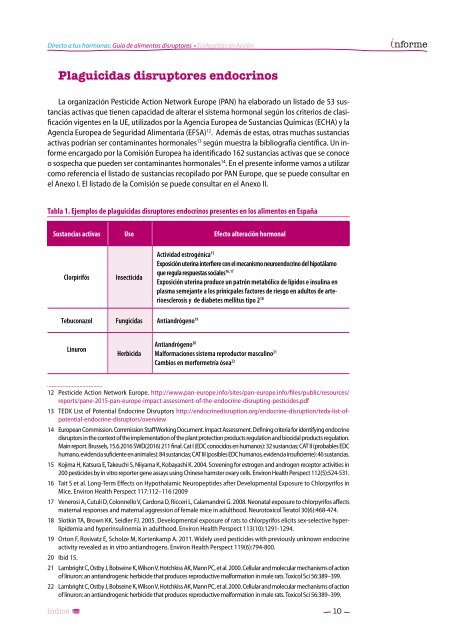Directo a tus hormonas Guía de alimentos disruptores
informe-plaguicidas-2016
informe-plaguicidas-2016
Create successful ePaper yourself
Turn your PDF publications into a flip-book with our unique Google optimized e-Paper software.
<strong>Directo</strong> a <strong>tus</strong> <strong>hormonas</strong>: <strong>Guía</strong> <strong>de</strong> <strong>alimentos</strong> <strong>disruptores</strong> • Ecologistas en Acción<br />
Plaguicidas <strong>disruptores</strong> endocrinos<br />
La organización Pestici<strong>de</strong> Action Network Europe (PAN) ha elaborado un listado <strong>de</strong> 53 sustancias<br />
activas que tienen capacidad <strong>de</strong> alterar el sistema hormonal según los criterios <strong>de</strong> clasificación<br />
vigentes en la UE, utilizados por la Agencia Europea <strong>de</strong> Sustancias Químicas (ECHA) y la<br />
Agencia Europea <strong>de</strong> Seguridad Alimentaria (EFSA) 12 . A<strong>de</strong>más <strong>de</strong> estas, otras muchas sustancias<br />
activas podrían ser contaminantes hormonales 13 según muestra la bibliografía científica. Un informe<br />
encargado por la Comisión Europea ha i<strong>de</strong>ntificado 162 sustancias activas que se conoce<br />
o sospecha que pue<strong>de</strong>n ser contaminantes hormonales 14 . En el presente informe vamos a utilizar<br />
como referencia el listado <strong>de</strong> sustancias recopilado por PAN Europe, que se pue<strong>de</strong> consultar en<br />
el Anexo I. El listado <strong>de</strong> la Comisión se pue<strong>de</strong> consultar en el Anexo II.<br />
Tabla 1. Ejemplos <strong>de</strong> plaguicidas <strong>disruptores</strong> endocrinos presentes en los <strong>alimentos</strong> en España<br />
Sustancias activas Uso Efecto alteración hormonal<br />
Clorpirifós<br />
Insecticida<br />
Actividad estrogénica 15<br />
Exposición uterina interfiere con el mecanismo neuroendocrino <strong>de</strong>l hipotálamo<br />
16, 17<br />
que regula respuestas sociales<br />
Exposición uterina produce un patrón metabólico <strong>de</strong> lípidos e insulina en<br />
plasma semejante a los prinicpales factores <strong>de</strong> riesgo en adultos <strong>de</strong> arterioesclerosis<br />
y <strong>de</strong> diabetes melli<strong>tus</strong> tipo 2 18<br />
Tebuconazol Fungicidas Antiandrógeno 19<br />
Linuron<br />
Herbicida<br />
Antiandrógeno 20<br />
Malformaciones sistema reproductor masculino 21<br />
Cambios en morformetría ósea 22<br />
12 Pestici<strong>de</strong> Action Network Europe. http://www.pan-europe.info/sites/pan-europe.info/files/public/resources/<br />
reports/pane-2015-pan-europe-impact-assessment-of-the-endocrine-disrupting-pestici<strong>de</strong>s.pdf<br />
13 TEDX List of Potential Endocrine Disruptors http://endocrinedisruption.org/endocrine-disruption/tedx-list-ofpotential-endocrine-disruptors/overview<br />
14 European Commission. Commission Staff Working Document. Impact Assessment. Defining criteria for i<strong>de</strong>ntifying endocrine<br />
disruptors in the context of the implementation of the plant protection products regulation and biocidal products regulation.<br />
Main report. Brussels, 15.6.2016 SWD(2016) 211 final. Cat I (EDC conocidos en humanos): 32 sustancias; CAT II (probables EDC<br />
humano, evi<strong>de</strong>ncia suficiente en animales): 84 sustancias; CAT III (posibles EDC humanos, evi<strong>de</strong>ncia insuficiente): 46 sustancias.<br />
15 Kojima H, Katsura E, Takeuchi S, Niiyama K, Kobayashi K. 2004. Screening for estrogen and androgen receptor activities in<br />
200 pestici<strong>de</strong>s by in vitro reporter gene assays using Chinese hamster ovary cells. Environ Health Perspect 112(5):524-531.<br />
16 Tait S et al. Long-Term Effects on Hypothalamic Neuropepti<strong>de</strong>s after Developmental Exposure to Chlorpyrifos in<br />
Mice. Environ Health Perspect 117:112–116 (2009<br />
17 Venerosi A, Cutuli D, Colonnello V, Cardona D, Ricceri L, Calamandrei G. 2008. Neonatal exposure to chlorpyrifos affects<br />
maternal responses and maternal aggression of female mice in adulthood. Neurotoxicol Teratol 30(6):468-474.<br />
18 Slotkin TA, Brown KK, Seidler FJ. 2005. Developmental exposure of rats to chlorpyrifos elicits sex-selective hyperlipi<strong>de</strong>mia<br />
and hyperinsulinemia in adulthood. Environ Health Perspect 113(10):1291-1294.<br />
19 Orton F, Rosivatz E, Scholze M, Kortenkamp A. 2011. Wi<strong>de</strong>ly used pestici<strong>de</strong>s with previously unknown endocrine<br />
activity revealed as in vitro antiandrogens. Environ Health Perspect 119(6):794-800.<br />
20 Ibid 15.<br />
21 Lambright C, Ostby J, Bobseine K, Wilson V, Hotchkiss AK, Mann PC, et al. 2000. Cellular and molecular mechanisms of action<br />
of linuron: an antiandrogenic herbici<strong>de</strong> that produces reproductive malformation in male rats. Toxicol Sci 56:389–399.<br />
22 Lambright C, Ostby J, Bobseine K, Wilson V, Hotchkiss AK, Mann PC, et al. 2000. Cellular and molecular mechanisms of action<br />
of linuron: an antiandrogenic herbici<strong>de</strong> that produces reproductive malformation in male rats. Toxicol Sci 56:389–399.<br />
índice<br />
10


